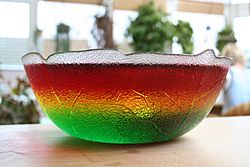Götterspeise facts for kids

Ampelpudding ("traffic light pudding")
|
|
| Alternative names | Wackelpudding, Wackelpeter, Froschsülze |
|---|---|
| Type | Pudding |
| Course | Dessert |
| Place of origin | Germany |
| Main ingredients | Gelatine or other gelling agent, sugar, flavourings, food colouring |
Götterspeise (say "GUR-ter-spy-zuh") is a fun German dessert. It means "dish of the gods." It's a lot like the jelly or Jell-O you might know. This wobbly treat is made from gelatin (which makes it jiggly), sugar, yummy flavors, and food colors.
In Germany, people also call it Wackelpudding ("wobbly pudding") or Wackelpeter ("Wobbly Peter"). If it's green, some even call it Froschsülze ("frog jelly") because of its color! People often enjoy Götterspeise with whipped cream or a smooth vanilla sauce.
Some of the most popular flavors are:
- Woodruff (called Waldmeister in German) – this one is green.
- Raspberry (Himbeere) – a classic red.
- Cherry (Kirsche) – another popular red flavor.
- Lemon (Zitrone) – bright yellow.
It's interesting to know that the green Götterspeise doesn't get its color from woodruff itself. Woodruff gives it a special smell and taste. Because a natural part of woodruff can be harmful in large amounts, only artificial woodruff flavor is used in stores. This makes sure it's safe to eat!
A really cool type of Götterspeise is called Ampelpudding ("traffic light pudding"). It has three layers and three colors: red, yellow, and green. Each layer is made and cooled separately before the next one is added. This makes it look just like a traffic light!
How Götterspeise Gets Its Color
Götterspeise gets its bright colors from special food colorings. These are often artificial colors that help make the dessert look appealing.
Here are some of the colors used:
- Red colors: These can include colors like azorubine (E 122) or cochineal red A (E 124).
- Yellow colors: You might find sunset yellow FCF (E 110) or quinoline yellow WS (E 104) used for yellow.
- Green colors: To make green, food colorings like quinoline yellow WS (E 104) and patent blue V (E 131) are often mixed.
Why It's Called Wackelpeter
The name Wackelpeter came about in the 1800s. Back then, "Peter" was a common nickname used in a funny way to describe things. Think of it like calling something "Wobbly Bob" today!
The "wackel" part of the name comes from the German word wackelt, which means "wobbles." If you shake the dessert, you'll see it really does wobble! So, Wackelpeter or Wackelpudding simply means a "wobbly pudding."

